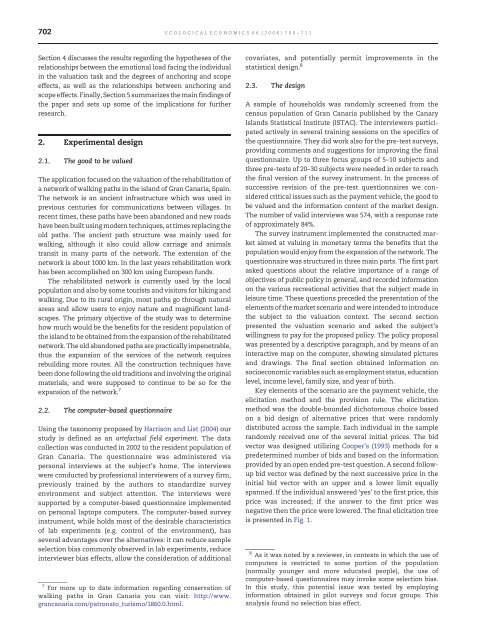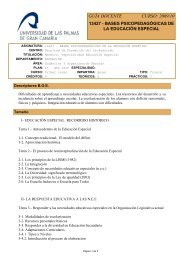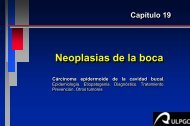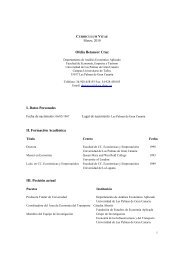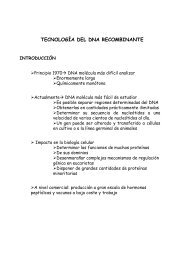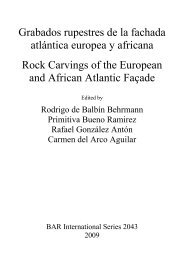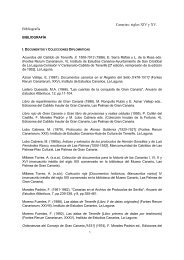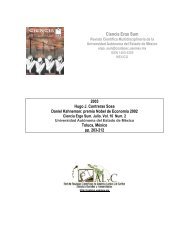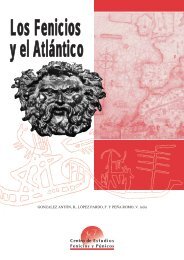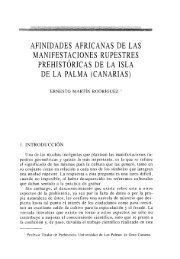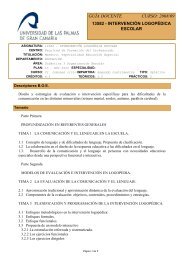Do emotions matter? Coherent preferences under anchoring and ...
Do emotions matter? Coherent preferences under anchoring and ...
Do emotions matter? Coherent preferences under anchoring and ...
Create successful ePaper yourself
Turn your PDF publications into a flip-book with our unique Google optimized e-Paper software.
702 ECOLOGICAL ECONOMICS 66 (2008) 700– 711Section 4 discusses the results regarding the hypotheses of therelationships between the emotional load facing the individualin the valuation task <strong>and</strong> the degrees of <strong>anchoring</strong> <strong>and</strong> scopeeffects, as well as the relationships between <strong>anchoring</strong> <strong>and</strong>scope effects. Finally, Section 5 summarizes the main findings ofthe paper <strong>and</strong> sets up some of the implications for furtherresearch.2. Experimental design2.1. The good to be valuedThe application focused on the valuation of the rehabilitation ofa network of walking paths in the isl<strong>and</strong> of Gran Canaria, Spain.The network is an ancient infrastructure which was used inprevious centuries for communications between villages. Inrecent times, these paths have been ab<strong>and</strong>oned <strong>and</strong> new roadshave been built using modern techniques, at times replacing theold paths. The ancient path structure was mainly used forwalking, although it also could allow carriage <strong>and</strong> animalstransit in many parts of the network. The extension of thenetwork is about 1000 km. In the last years rehabilitation workhas been accomplished on 300 km using European funds.The rehabilitated network is currently used by the localpopulation <strong>and</strong> also by some tourists <strong>and</strong> visitors for hiking <strong>and</strong>walking. Due to its rural origin, most paths go through naturalareas <strong>and</strong> allow users to enjoy nature <strong>and</strong> magnificent l<strong>and</strong>scapes.The primary objective of the study was to determinehow much would be the benefits for the resident population ofthe isl<strong>and</strong> to be obtained from the expansion of the rehabilitatednetwork. The old ab<strong>and</strong>oned paths are practically impenetrable,thus the expansion of the services of the network requiresrebuilding more routes. All the construction techniques havebeen done following the old traditions <strong>and</strong> involving the originalmaterials, <strong>and</strong> were supposed to continue to be so for theexpansion of the network. 72.2. The computer-based questionnaireUsing the taxonomy proposed by Harrison <strong>and</strong> List (2004) ourstudy is defined as an artefactual field experiment. The datacollection was conducted in 2002 to the resident population ofGran Canaria. The questionnaire was administered viapersonal interviews at the subject's home. The interviewswere conducted by professional interviewers of a survey firm,previously trained by the authors to st<strong>and</strong>ardize surveyenvironment <strong>and</strong> subject attention. The interviews weresupported by a computer-based questionnaire implementedon personal laptops computers. The computer-based surveyinstrument, while holds most of the desirable characteristicsof lab experiments (e.g. control of the environment), hasseveral advantages over the alternatives: it can reduce sampleselection bias commonly observed in lab experiments, reduceinterviewer bias effects, allow the consideration of additional7 For more up to date information regarding conservation ofwalking paths in Gran Canaria you can visit: http://www.grancanaria.com/patronato_turismo/1860.0.html.covariates, <strong>and</strong> potentially permit improvements in thestatistical design. 82.3. The designA sample of households was r<strong>and</strong>omly screened from thecensus population of Gran Canaria published by the CanaryIsl<strong>and</strong>s Statistical Institute (ISTAC). The interviewers participatedactively in several training sessions on the specifics ofthe questionnaire. They did work also for the pre-test surveys,providing comments <strong>and</strong> suggestions for improving the finalquestionnaire. Up to three focus groups of 5–10 subjects <strong>and</strong>three pre-tests of 20–30 subjects were needed in order to reachthe final version of the survey instrument. In the process ofsuccessive revision of the pre-test questionnaires we consideredcritical issues such as the payment vehicle, the good tobe valued <strong>and</strong> the information content of the market design.The number of valid interviews was 574, with a response rateof approximately 84%.The survey instrument implemented the constructed marketaimed at valuing in monetary terms the benefits that thepopulation would enjoy from the expansion of the network. Thequestionnaire was structured in three main parts. The first partasked questions about the relative importance of a range ofobjectives of public policy in general, <strong>and</strong> recorded informationon the various recreational activities that the subject made inleisure time. These questions preceded the presentation of theelements of the market scenario <strong>and</strong> were intended to introducethe subject to the valuation context. The second sectionpresented the valuation scenario <strong>and</strong> asked the subject'swillingness to pay for the proposed policy. The policy proposalwas presented by a descriptive paragraph, <strong>and</strong> by means of aninteractive map on the computer, showing simulated pictures<strong>and</strong> drawings. The final section obtained information onsocioeconomic variables such as employment status, educationlevel, income level, family size, <strong>and</strong> year of birth.Key elements of the scenario are the payment vehicle, theelicitation method <strong>and</strong> the provision rule. The elicitationmethod was the double-bounded dichotomous choice basedon a bid design of alternative prices that were r<strong>and</strong>omlydistributed across the sample. Each individual in the sampler<strong>and</strong>omly received one of the several initial prices. The bidvector was designed utilizing Cooper's (1993) methods for apredetermined number of bids <strong>and</strong> based on the informationprovided by an open ended pre-test question. A second followupbid vector was defined by the next successive price in theinitial bid vector with an upper <strong>and</strong> a lower limit equallyspanned. If the individual answered ‘yes’ to the first price, thisprice was increased; if the answer to the first price wasnegative then the price were lowered. The final elicitation treeis presented in Fig. 1.8 As it was noted by a reviewer, in contexts in which the use ofcomputers is restricted to some portion of the population(normally younger <strong>and</strong> more educated people), the use ofcomputer-based questionnaires may invoke some selection bias.In this study, this potential issue was tested by employinginformation obtained in pilot surveys <strong>and</strong> focus groups. Thisanalysis found no selection bias effect.


